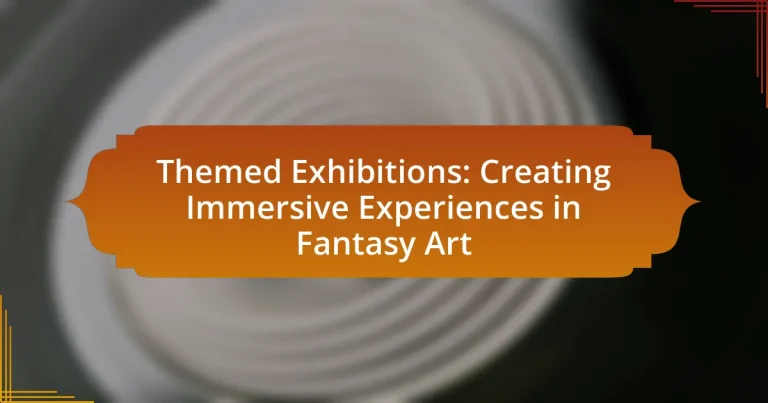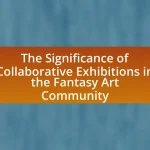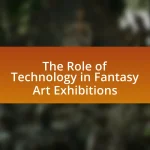Themed exhibitions in fantasy art are curated displays that focus on specific concepts, narratives, or motifs within the fantasy genre, featuring a variety of artworks such as paintings, sculptures, and digital art. These exhibitions differ from traditional art displays by creating cohesive experiences centered around a unified theme, enhancing viewer engagement through immersive environments and interactive elements. Key characteristics of fantasy art, including imaginative worlds and emotional resonance, contribute to the effectiveness of these exhibitions in promoting cultural dialogue and understanding. The article explores the design, curation, and impact of themed exhibitions, highlighting their role in enhancing visitor experiences and fostering appreciation for fantasy art.
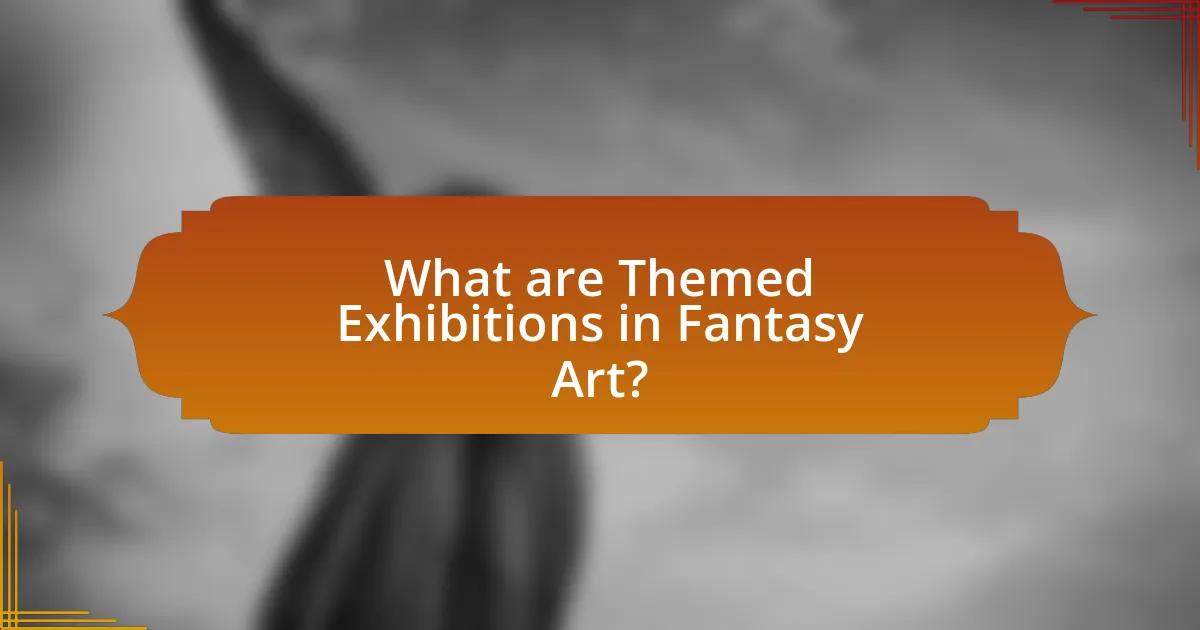
What are Themed Exhibitions in Fantasy Art?
Themed exhibitions in fantasy art are curated displays that focus on specific concepts, narratives, or motifs within the fantasy genre. These exhibitions often feature a collection of artworks, including paintings, sculptures, and digital art, that explore a unified theme, such as mythical creatures, epic landscapes, or fantastical worlds. For example, exhibitions may highlight the works of renowned fantasy artists like Frank Frazetta or Brian Froud, showcasing their unique interpretations of fantasy elements. Themed exhibitions aim to create immersive experiences for viewers, allowing them to engage with the art on a deeper level and appreciate the creativity and imagination inherent in fantasy art.
How do Themed Exhibitions differ from traditional art exhibitions?
Themed exhibitions differ from traditional art exhibitions primarily in their focus and presentation style. Themed exhibitions center around a specific concept, narrative, or idea, creating a cohesive experience that guides the viewer through a curated selection of artworks related to that theme. In contrast, traditional art exhibitions typically showcase artworks based on the artist, medium, or period without a unifying narrative. For example, a themed exhibition might explore the concept of “fantasy” through various artists and mediums, while a traditional exhibition might simply display a collection of paintings from a single artist. This thematic approach enhances viewer engagement by providing context and a deeper understanding of the artworks, making the experience more immersive.
What elements define a themed exhibition in the context of fantasy art?
A themed exhibition in the context of fantasy art is defined by cohesive visual storytelling, immersive environments, and interactive elements. Cohesive visual storytelling ensures that artworks are curated to convey a unified narrative or theme, often drawing from mythology, folklore, or original fantasy worlds. Immersive environments enhance the viewer’s experience by transforming the exhibition space with thematic decor, lighting, and soundscapes that reflect the fantasy genre. Interactive elements, such as augmented reality features or hands-on installations, engage visitors actively, allowing them to explore and connect with the art on a deeper level. These elements collectively create an engaging and memorable experience that resonates with the audience, exemplified by exhibitions like “The Art of Pixar” which utilized these strategies to captivate viewers.
Why are themes important in creating immersive experiences?
Themes are crucial in creating immersive experiences because they provide a cohesive narrative framework that guides the audience’s emotional and cognitive engagement. A well-defined theme enhances the connection between the audience and the content, allowing for deeper exploration and interaction. For instance, in themed exhibitions, a consistent theme can evoke specific emotions and memories, making the experience more relatable and memorable. Research indicates that thematic consistency can significantly enhance visitor satisfaction and retention, as seen in studies conducted by the American Alliance of Museums, which highlight that visitors are more likely to engage with and remember exhibits that have a clear and compelling theme.
What role does fantasy art play in themed exhibitions?
Fantasy art serves as a central element in themed exhibitions by creating immersive environments that engage viewers’ imaginations. This genre of art often features fantastical elements, such as mythical creatures and otherworldly landscapes, which transport audiences into alternate realities. The incorporation of fantasy art in exhibitions enhances the thematic narrative, allowing for a cohesive storytelling experience that captivates visitors. For instance, exhibitions like “The Art of Fantasy” at the Museum of Pop Culture have successfully utilized fantasy art to draw connections between visual art and popular culture, demonstrating its ability to resonate with diverse audiences and stimulate emotional responses.
How does fantasy art enhance the immersive experience for visitors?
Fantasy art enhances the immersive experience for visitors by creating visually captivating environments that stimulate imagination and emotional engagement. This genre of art often features intricate details, vibrant colors, and fantastical elements that transport viewers into alternate realities, making them feel as though they are part of the narrative. Research indicates that immersive environments can increase emotional responses and cognitive engagement, leading to a more memorable experience. For instance, studies show that visitors to themed exhibitions featuring fantasy art report higher levels of enjoyment and connection to the artwork, as the art encourages exploration and interaction within the space.
What are the key characteristics of fantasy art that contribute to themed exhibitions?
The key characteristics of fantasy art that contribute to themed exhibitions include imaginative worlds, intricate details, and emotional resonance. Imaginative worlds transport viewers to realms beyond reality, allowing for immersive experiences that engage the audience’s creativity. Intricate details in fantasy art, such as elaborate costumes, mythical creatures, and fantastical landscapes, enhance visual storytelling and draw viewers into the narrative. Emotional resonance is achieved through themes of adventure, heroism, and the exploration of the human condition, which connect with audiences on a personal level. These characteristics collectively create an engaging atmosphere that enhances the thematic focus of exhibitions, making them memorable and impactful.
Why are immersive experiences significant in art exhibitions?
Immersive experiences are significant in art exhibitions because they enhance audience engagement and emotional connection to the artwork. By utilizing technology, interactive elements, and sensory stimuli, these experiences allow visitors to participate actively rather than passively observe. Research indicates that immersive environments can increase retention of information and foster a deeper understanding of the themes presented, as seen in exhibitions like “TeamLab Borderless,” which attracted over 2 million visitors in its first year, demonstrating the appeal and effectiveness of such experiences in drawing crowds and creating memorable interactions with art.
How do immersive experiences affect visitor engagement and interaction?
Immersive experiences significantly enhance visitor engagement and interaction by creating a multi-sensory environment that captivates attention and fosters emotional connections. Research indicates that immersive environments, such as themed exhibitions, can increase visitor retention rates by up to 40% compared to traditional displays, as they encourage active participation and exploration. For instance, studies have shown that visitors in immersive settings are more likely to interact with exhibits, ask questions, and share their experiences, leading to deeper learning and satisfaction. This heightened engagement is attributed to the ability of immersive experiences to stimulate curiosity and evoke emotions, making the overall visit more memorable and impactful.
What psychological impacts do immersive experiences have on audiences?
Immersive experiences significantly enhance emotional engagement and cognitive processing in audiences. These experiences often lead to heightened empathy, as participants can deeply connect with narratives and characters, fostering a sense of presence and involvement. Research indicates that immersive environments can activate brain regions associated with emotional responses, such as the amygdala, which enhances the retention of information and personal relevance of the experience. For instance, a study published in the journal “Computers in Human Behavior” by Slater and Wilbur (1997) demonstrates that virtual reality can evoke strong emotional reactions, leading to lasting memories and behavioral changes. This evidence supports the notion that immersive experiences profoundly affect psychological states, influencing how audiences perceive and interact with art and narratives.
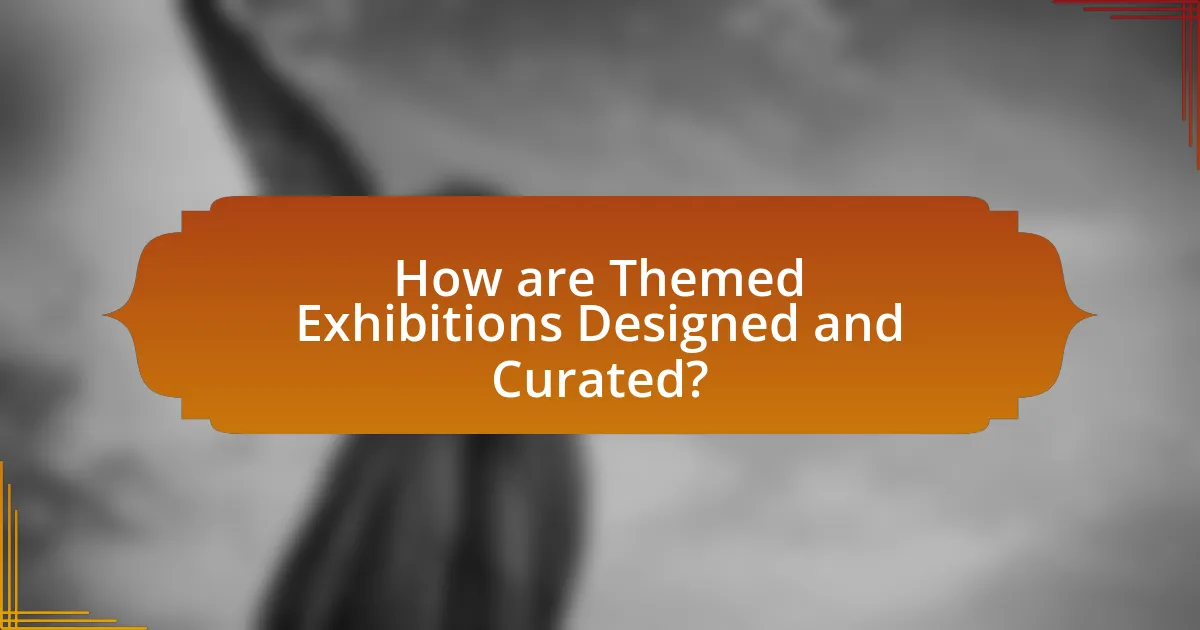
How are Themed Exhibitions Designed and Curated?
Themed exhibitions are designed and curated through a systematic process that involves selecting a central theme, researching relevant artworks, and creating an engaging narrative. Curators begin by identifying a specific concept or theme that resonates with the audience, such as fantasy art, which allows for a cohesive presentation of works. They then conduct thorough research to gather artworks that align with the theme, considering historical context, artistic styles, and the emotional impact of the pieces.
Once the artworks are selected, curators develop a narrative that guides the visitor experience, often incorporating interactive elements or multimedia to enhance engagement. This narrative is supported by educational materials, such as labels and catalogs, that provide context and insights into the artworks. The layout of the exhibition space is also meticulously planned to facilitate a logical flow and encourage exploration.
For instance, the “Fantasy Art: Beyond Imagination” exhibition at the Museum of Modern Art showcased various artists’ interpretations of fantasy, using immersive installations to draw visitors into the thematic experience. This approach not only highlights the artworks but also fosters a deeper understanding of the genre’s significance in contemporary culture.
What are the essential steps in designing a themed exhibition?
The essential steps in designing a themed exhibition include defining the theme, conducting research, developing a narrative, selecting and organizing exhibits, designing the layout, and planning the marketing strategy. Defining the theme establishes the core concept that guides all other decisions, while research ensures the theme is well-supported and relevant. Developing a narrative helps create a cohesive story that engages visitors. Selecting and organizing exhibits involves choosing artworks and artifacts that align with the theme, ensuring they are displayed in a logical and appealing manner. Designing the layout focuses on the physical arrangement of the exhibition space to enhance visitor experience. Finally, planning the marketing strategy is crucial for attracting an audience and promoting the exhibition effectively. These steps are validated by industry practices in exhibition design, which emphasize the importance of a structured approach to create impactful experiences.
How do curators select artworks for a themed exhibition?
Curators select artworks for a themed exhibition by establishing a clear concept that aligns with the exhibition’s theme, such as fantasy art. They research and evaluate artworks based on criteria like relevance to the theme, artistic quality, and the narrative they contribute to the overall experience. Curators often consider the historical context and significance of each piece, ensuring that the selected artworks collectively create an immersive experience for the audience. This process may involve consultations with artists, galleries, and collectors to source appropriate pieces, as well as logistical considerations such as space and installation requirements.
What factors influence the layout and design of the exhibition space?
The layout and design of the exhibition space are influenced by factors such as the theme of the exhibition, the target audience, and the flow of visitor traffic. The theme dictates the visual and spatial elements, ensuring that the design aligns with the intended narrative and atmosphere. For instance, a fantasy art exhibition may require immersive environments that reflect the artwork’s themes, utilizing props and lighting to enhance the experience. The target audience influences design choices, as different demographics may respond to various styles and layouts, necessitating a design that engages and captivates them. Additionally, the flow of visitor traffic is crucial; effective layouts facilitate movement and interaction, guiding visitors through the space in a way that maximizes engagement with the exhibits. Research indicates that well-planned layouts can increase visitor satisfaction and retention, highlighting the importance of these factors in creating successful exhibitions.
How do technology and multimedia enhance themed exhibitions?
Technology and multimedia enhance themed exhibitions by creating immersive experiences that engage visitors on multiple sensory levels. For instance, interactive displays allow attendees to participate actively, fostering a deeper connection with the exhibition’s themes. Additionally, augmented reality (AR) and virtual reality (VR) technologies can transport visitors into fantastical environments, making the art more relatable and memorable. Studies have shown that exhibitions incorporating multimedia elements can increase visitor retention and satisfaction by up to 30%, demonstrating the effectiveness of these technologies in enhancing the overall experience.
What types of technology are commonly used in immersive fantasy art exhibitions?
Immersive fantasy art exhibitions commonly utilize virtual reality (VR), augmented reality (AR), projection mapping, and interactive installations. VR technology allows visitors to experience fantastical environments in a fully immersive manner, while AR enhances physical artworks with digital overlays, creating a blended experience. Projection mapping transforms surfaces into dynamic displays, bringing static art to life through animation and visual effects. Interactive installations engage audiences by allowing them to influence the art through their actions, fostering a deeper connection with the fantasy themes presented. These technologies collectively enhance the sensory experience and engagement of visitors, making the exhibitions more memorable and impactful.
How does multimedia storytelling contribute to the overall experience?
Multimedia storytelling enhances the overall experience by engaging multiple senses, which fosters deeper emotional connections and understanding. By integrating visual, auditory, and interactive elements, such as videos, soundscapes, and digital displays, themed exhibitions in fantasy art create immersive environments that captivate audiences. Research indicates that experiences involving multiple sensory modalities can increase retention and engagement by up to 70%, demonstrating the effectiveness of multimedia in enhancing visitor experiences.
What challenges do curators face when creating themed exhibitions?
Curators face several challenges when creating themed exhibitions, including selecting cohesive artworks, managing budgets, and ensuring audience engagement. The selection of artworks must align with the theme while also appealing to diverse audience interests, which can limit available options. Budget constraints often restrict the ability to acquire or transport desired pieces, impacting the overall quality of the exhibition. Additionally, curators must develop strategies to engage visitors effectively, as immersive experiences are crucial for themed exhibitions, particularly in the realm of fantasy art, where the goal is to transport audiences into imaginative worlds. These challenges require careful planning and resource management to create a successful exhibition.
How can budget constraints impact the design and execution of an exhibition?
Budget constraints significantly limit the design and execution of an exhibition by restricting the resources available for materials, technology, and overall presentation. When financial limitations are present, exhibition planners may have to compromise on the quality of displays, reduce the number of artworks showcased, or forgo advanced interactive technologies that enhance visitor engagement. For instance, a study by the American Alliance of Museums indicates that 70% of museums report budget constraints as a primary factor affecting their ability to create innovative exhibitions. This directly impacts the immersive experience intended in themed exhibitions, such as those focused on fantasy art, where high-quality visuals and interactive elements are crucial for audience engagement.
What strategies can be employed to overcome logistical challenges?
To overcome logistical challenges in themed exhibitions, effective strategies include thorough planning, collaboration with stakeholders, and the use of technology. Thorough planning involves creating detailed timelines and checklists to ensure all aspects of the exhibition are addressed, which minimizes last-minute issues. Collaboration with stakeholders, such as artists, vendors, and venue managers, fosters communication and alignment on expectations, reducing misunderstandings. The use of technology, such as project management software and inventory tracking systems, enhances efficiency and allows for real-time updates on progress and resource availability. These strategies are supported by industry practices that emphasize the importance of preparation and teamwork in successful exhibition management.

What are the Outcomes and Impact of Themed Exhibitions?
The outcomes and impact of themed exhibitions include enhanced visitor engagement, increased educational value, and promotion of cultural appreciation. Themed exhibitions create immersive experiences that captivate audiences, leading to higher attendance rates; for instance, a study by the American Alliance of Museums found that themed exhibitions can increase visitor numbers by up to 30%. Additionally, these exhibitions often provide educational programming that deepens understanding of the subject matter, fostering a greater appreciation for the art and culture presented. Themed exhibitions also contribute to community identity and pride, as they often reflect local culture and history, thereby strengthening social bonds among attendees.
How do themed exhibitions influence public perception of fantasy art?
Themed exhibitions significantly influence public perception of fantasy art by providing immersive experiences that contextualize the artwork within specific narratives or themes. These exhibitions often curate a selection of pieces that resonate with a particular concept, allowing viewers to engage with the art on a deeper emotional and intellectual level. For instance, exhibitions like “The Art of Fantasy” at the Museum of Pop Culture have showcased works from various artists, enhancing appreciation and understanding of the genre by linking visual elements to storytelling and cultural references. This contextual framing can shift public perception, making fantasy art more accessible and relatable, as evidenced by increased attendance and positive feedback from visitors who report a greater appreciation for the genre after experiencing such exhibitions.
What role do themed exhibitions play in promoting emerging artists?
Themed exhibitions play a crucial role in promoting emerging artists by providing them with a platform to showcase their work in a curated context that attracts specific audiences. These exhibitions often focus on particular themes or concepts, allowing emerging artists to connect their creations to broader narratives, which can enhance visibility and engagement. For instance, themed exhibitions in fantasy art can draw in enthusiasts who are specifically interested in that genre, thereby increasing the likelihood of sales and networking opportunities for the artists involved. Additionally, such exhibitions often receive media attention and can lead to critical reviews, further elevating the profiles of the participating artists.
How can themed exhibitions contribute to cultural dialogue and understanding?
Themed exhibitions contribute to cultural dialogue and understanding by providing immersive experiences that showcase diverse perspectives and narratives. These exhibitions often highlight specific cultural themes, allowing visitors to engage with art and artifacts that reflect the values, beliefs, and histories of different communities. For instance, exhibitions focused on indigenous cultures can foster appreciation and respect for those traditions, while also addressing historical injustices. Research indicates that such exhibitions can enhance empathy and awareness among audiences, as they encourage visitors to reflect on their own cultural identities in relation to others. By facilitating conversations around shared human experiences, themed exhibitions serve as platforms for cultural exchange and mutual understanding.
What metrics are used to evaluate the success of themed exhibitions?
The success of themed exhibitions is evaluated using metrics such as visitor attendance, visitor engagement, and post-exhibition surveys. Visitor attendance quantifies the number of individuals who attended the exhibition, providing a direct measure of interest and reach. Visitor engagement can be assessed through interactive elements, social media interactions, and time spent at the exhibition, indicating how effectively the exhibition captivated its audience. Post-exhibition surveys gather qualitative feedback from attendees regarding their experiences, satisfaction levels, and educational impact, offering insights into the exhibition’s effectiveness in achieving its thematic goals. These metrics collectively provide a comprehensive understanding of an exhibition’s success in creating immersive experiences in fantasy art.
How is visitor feedback collected and analyzed post-exhibition?
Visitor feedback is collected through surveys, interviews, and digital platforms after an exhibition. These methods allow organizers to gather quantitative and qualitative data regarding visitor experiences, preferences, and suggestions for improvement. Surveys often include structured questions that can be statistically analyzed, while interviews provide deeper insights into visitor sentiments. Digital platforms, such as social media and exhibition websites, facilitate ongoing feedback collection and engagement. Analyzing this feedback involves compiling data to identify trends, measuring satisfaction levels, and assessing the overall impact of the exhibition, which can inform future programming and enhance visitor experiences.
What are the indicators of a successful immersive experience?
Indicators of a successful immersive experience include high levels of engagement, emotional resonance, and participant feedback. Engagement is measured by the extent to which participants interact with the environment and content, often indicated by time spent and active participation. Emotional resonance is assessed through the emotional responses elicited from participants, which can be gauged via surveys or observational studies. Participant feedback, collected through interviews or questionnaires, provides direct insights into their experiences and satisfaction levels. Research shows that immersive experiences that effectively combine these elements lead to greater retention of information and a more profound overall impact on participants.
What best practices should be followed when creating themed exhibitions?
When creating themed exhibitions, it is essential to establish a clear concept that resonates with the audience and aligns with the exhibition’s objectives. This involves thorough research on the theme, ensuring that all elements, including artwork, layout, and narrative, cohesively support the central idea. For instance, a successful themed exhibition in fantasy art might incorporate interactive installations that engage visitors, enhancing their immersive experience.
Additionally, effective use of lighting and sound can significantly influence the atmosphere, making the theme more compelling. According to a study by the American Alliance of Museums, well-designed exhibitions can increase visitor engagement by up to 40%. Furthermore, incorporating educational components, such as guided tours or workshops, can deepen understanding and appreciation of the theme, fostering a more enriching experience.
Lastly, soliciting feedback from visitors post-exhibition can provide valuable insights for future improvements, ensuring that the exhibition continues to evolve and meet audience expectations.
How can curators ensure inclusivity and accessibility in themed exhibitions?
Curators can ensure inclusivity and accessibility in themed exhibitions by implementing universal design principles and actively engaging diverse communities in the planning process. Universal design principles involve creating spaces and experiences that accommodate a wide range of abilities, such as providing wheelchair access, sensory-friendly environments, and materials in multiple formats (e.g., braille, audio descriptions). Engaging diverse communities allows curators to understand the needs and preferences of various groups, ensuring that the exhibition reflects a broad spectrum of perspectives and experiences. Research indicates that inclusive practices not only enhance visitor satisfaction but also increase attendance, as seen in studies conducted by the National Endowment for the Arts, which highlight the positive impact of accessibility on audience engagement.
What are the key considerations for engaging diverse audiences?
Key considerations for engaging diverse audiences include understanding cultural backgrounds, preferences, and accessibility needs. Engaging diverse audiences requires tailored communication strategies that resonate with various cultural contexts, ensuring that content is relevant and relatable. For instance, research indicates that inclusive programming can increase participation rates by up to 30%, highlighting the importance of representation in themes and narratives. Additionally, providing materials in multiple languages and ensuring physical accessibility can enhance the experience for all attendees, fostering a more inclusive environment.
